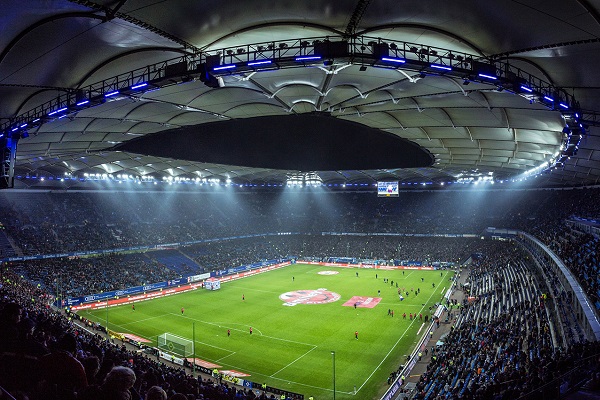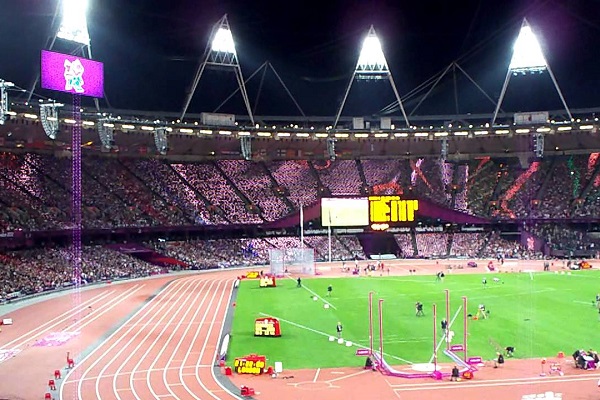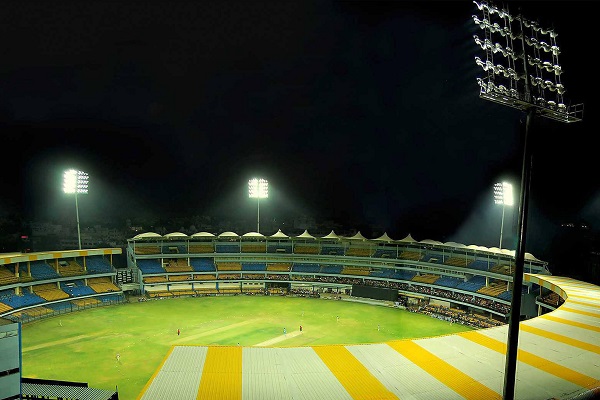The importance of stadium lighting
For a modern stadium, it is not only required to have a beautiful appearance and complete equipment for various sports, but also to have a good lighting environment, that is, to have suitable and uniform illumination and brightness, ideal light color, and three-dimensional lighting. Glare, etc. In addition to ensuring a good viewing effect for the audience, it must also ensure the lighting requirements required by the referees, athletes and competition items, as well as a good TV broadcast effect. Therefore, good lighting plays an important role in modern stadiums.

Generally speaking, in the lighting design of a stadium, the following three factors should be considered:
1) Meet the visual requirements of athletes during sports competitions, and minimize the objective impact of lighting on the competition;
2) Meet the visual requirements of the audience and minimize the discomfort caused by the lights when watching the game;
3) Satisfy the lighting requirements of TV broadcasting and improve the broadcasting quality as much as possible;
In a word, lighting is closely related to the competition requirements of sports events, and is closely related to the viewing effect of the audience. A stadium without good lighting facilities is an incomplete stadium, which will seriously affect its use function.
Design standards for stadium lighting
In order to obtain a good lighting design scheme, reasonably use the distribution of light to meet the requirements of athletes, spectators, referees and good TV broadcast effects, it is necessary to determine lighting standards, including illuminance standards and lighting quality standards. Lighting quality standards, including glare, light source color temperature with color rendering requirements, light directionality, energy saving requirements, etc.

Illuminance standard
According to the 83rd recommended illuminance requirements of the International Sports Federation and the provisions in Article 2.2.9 of the “Lighting Design Standards for Civil Buildings” GBJ133-90, the following recommended illuminance standards are proposed:
1) According to Article 2.2.9-1 of “Lighting Design Standards for Civil Buildings” GBJ133-90:
The standard value of illuminance for football games: when the viewing distance is 120m, it is 150-200-300lux; when the viewing distance is 160m, it is 200-300-500lux; when the viewing distance is 200m, it is 300-500-750lux. The viewing distance refers to the distance from the last row of the auditorium to the sideline of the venue.
2) According to Article 2.2.9-2 of “Lighting Design Standards for Civil Buildings” GBJ133-90:
Vertical illuminance required for TV broadcasting: The maximum shooting distance is divided into three groups.
① For football events, the average vertical illuminance should be 750lux when the shooting distance is 25m; the average vertical illuminance should be 1000lux when the maximum shooting distance is 75m; The average vertical illuminance is 1500lux when the shooting distance is 150m.
② For track and field events, the average vertical illuminance should be 500lux when the maximum shooting distance is 25m; the average vertical illuminance should be 750lx when the maximum shooting distance is 75m; and 1000lux when the maximum shooting distance is 150m. Each of the above-mentioned vertical illuminances is used for a given motion level and a given maximum shooting distance relative to a 1.0m vertical plane, and the middle value of each illuminance value is used for other shooting distances.
3) The above-mentioned illuminance refers to the final average illuminance of the stadium. The initial illuminance selected in the design must be included in the maintenance factor, generally a value of 0.7-0.8 can be used.
4) Uniformity of horizontal illuminance: Illuminance uniformity is generally expressed by the ratio of the minimum illuminance to the maximum illuminance, and can also be expressed by the ratio of the minimum illuminance to the average illuminance. The ratio of the minimum illuminance to the maximum illuminance should be greater than 0.5.
5) Uniformity of vertical illuminance: The ratio of the minimum illuminance to the maximum illuminance should be greater than 0.4 to meet the requirements of the main TV camera.
Lighting quality standards
1) Glare
In addition to providing sufficient horizontal and vertical illumination, the key to sports lighting is to reduce glare to achieve a bright and glare-free effect. Glare is one of the most important factors affecting lighting quality. According to the CIE NO.83 publication “Sports Field Lighting for Television Systems”, the maximum glare index GRmax in the field should be less than 50, and the smaller the glare rating, the better the glare limit.
The glare rating GR is calculated by the following formula:
GR=27+24Lg*Lvl/Lve 0.9
In the formula, Lvl is the brightness of the light curtain generated by the lamp, and Lve is the brightness of the light curtain generated by the environment. Generally, when calculating the illuminance, the glare rated value GR in different directions should be calculated, and it is sufficient when GR <50. In addition to reasonably determining the selection, installation height and arrangement of lamps and lanterns, the limitation of glare can also be achieved by improving the background illumination of the arena.
2) Light source color temperature and color rendering requirements
In order to achieve a good color TV broadcast effect, the lighting quality of the stadium is not only related to the illuminance, but also closely related to the color temperature and color rendering of the lighting source. my country’s “Civil Building Lighting Design Standards” GBJ133-90 in Article 3.3.2 stipulates that the color rendering index Ra of the light source used for TV broadcasting should not be less than 65. According to the CIE NO.83 publication and the requirements of FIFA, the light source correlated color temperature Tc should be greater than 5000K and the light source color rendering index Ra should be greater than or equal to 80 to achieve the best on-site lighting effect and TV broadcast effect.
3) The directionality of light
The depression angle of the lamps not only affects the vertical illuminance, but also may have a greater glare effect on athletes, spectators and referees. The lighting design of the stadium should choose the aiming direction of the lamps. In addition, the proportion of light coming from the main camera and the other side should be controlled within a certain range, and the most important point of lighting is to be set in the center of the football field and in the restricted area.
4) Energy saving requirements
Lighting energy saving focuses on adopting reasonable lighting schemes and efficient lighting devices, reducing line loss and good lighting control. Sports buildings are construction projects that consume a large amount of electricity for lighting. In the sense of energy saving, only comparing the initial investment cost without selecting the lighting design based on the minimum operating cost is not a reasonable design. Investment and operating costs are considered comprehensively.
High-efficiency LED light sources and lamps should be selected to improve the power factor of the system. The lighting design should have a variety of lighting modes and corresponding control schemes. The number of lamps can be adjusted to provide suitable lighting for different competitions and activities. The control scheme should be simple, practical and flexible.
5) Illumination calculation of stadium lighting design
There are usually three methods for illuminance calculation of stadium lighting design:
One is the estimation method of capacity per unit area;
The second is the average illuminance calculation method, which is used to calculate the average illuminance on the illuminated surface;
The third is the point-by-point calculation method, which can accurately calculate the illuminance of a certain point.
Layout of stadium lighting fixtures
Whether the arrangement of lamps and lanterns is reasonable or not directly affects the effect and economy of site lighting. The lighting methods commonly used in current sports buildings are basically as follows: outdoor sports venues: light pole type, four-tower type, multi-tower type, light strip type, light strip and lighthouse hybrid type; indoor sports venues, Uniformly distributed, light-belt, hybrid.

Four-tower layout
Four lighthouses are set up at the four corners of the site, the height of the towers is generally 25-50m, and narrow beam lamps are commonly used. This type of arrangement is suitable for football fields without a running track, with low utilization rate of lighting, difficult maintenance and repair, and high cost. If the lighting quality is not too demanding, it can meet the general requirements of athletes and spectators. The appropriate position of the lighthouse can form a suitable illumination distribution on the field by aiming at the stadium lights with various beam angles. But today’s television broadcasts require high and uniform vertical illuminance, which requires that the angle of light incident on the farther part of the venue is much smaller than the specified limit. The effects of the higher brightness obtained with the use of large gas discharge lamps, combined with the traditional tower height, made it inevitable to generate excessive glare. The disadvantage of this four-tarpaulin form is that the visual changes in different viewing directions are large and the shadow is deep. From the perspective of TV broadcast, it is more difficult to meet the vertical illuminance in all directions and control the glare well. In order to meet the requirements of Ev/Eh 44 value and less glare, it is necessary to take some improvement measures for the four-tower lighting method:
1) Move the position of the four towers to the sides and outside the sideline, so that the opposite and four corners of the venue can obtain a certain vertical illumination;
2) Increase the number of stadium lights on the lighthouse on the side of the TV main camera to enhance beam projection;
3) Supplement the light strip lighting on the top of the stand on the side of the TV main camera direction, and pay attention to controlling the glare, so that the audience at both ends of the venue should not notice it.
Multi-tower arrangement
This form of lighting is set with low lighthouses (or light poles) on both sides of the field, which is suitable for practice fields, such as football, volleyball, tennis courts, etc. Its outstanding advantages are that the electricity consumption is relatively low, and the vertical illumination and horizontal illumination are better. Due to the lower light pole, this arrangement also has the advantages of low investment and convenient maintenance.
The light poles should be arranged evenly, 6 towers or 8 towers can be arranged, the height of the light poles should not be less than 12m, the projection angle should be between l50-250, the maximum projection angle to the sideline of the venue should not exceed 750, and the minimum should not be less than 450. Generally, medium beam and wide beam stadium lights are used. If there are spectator stands, the arrangement of aiming points should be very careful. The disadvantage of this kind of lighting is that when the light pole is arranged between the venue and the auditorium, it will block the audience’s sight and eliminate the shadow. In football fields without TV broadcast, the lateral arrangement of lighting devices mostly adopts the multi-tower arrangement instead of the light strip arrangement. The lighthouses are usually arranged on the east and west sides of the arena. Generally speaking, the height of the lighthouses of the multi-tab lights can be lower than that of the four corners. There are four towers, six towers, eight towers and other layouts in the multi-tower arrangement. In order to avoid visual disturbance to the goalkeeper, the midpoint of the goal line is used as the reference point, and lighthouses cannot be placed within at least 10m on both sides of the bottom line.
For the calculation of the lighthouse height of the multi-tab light, the triangle is perpendicular to the stadium and parallel to the bottom line, ≥250, and the height of the lighthouse is ≥15m.
Light belt arrangement
Arrange the lamps in rows on both sides of the court to form a lighting system with continuous light strips. Its lighting uniformity, the brightness between the players and the court is better. At present, it is recognized in the world that this way of lighting is the best, and can meet the various requirements of TV broadcasts for lighting. The length of the light strip should exceed the goal line by more than 10m (for example, in a sports field with a runway, the length of the light strip should preferably not be less than 180m) to ensure that the goal area has sufficient vertical illumination from behind. At this time, the projection angle can be reduced to about 200. If a low-brightness lamp is used, it can be further reduced to about 150. Some stadium light strip lighting is very close to the side line of the field (the included angle is above 650), and the side of the field cannot obtain enough vertical illumination, so it is necessary to increase the “recessed” supplementary lighting.
In general, the light-belt arrangement uses a combination of several stadium lights with different beam angles. The narrow beam is used for long shots, and the medium beam is used for close shots. The disadvantage of the light-belt arrangement is that the glare control technology is relatively strict, and the object’s sense of reality is slightly worse.
Hybrid layout
Hybrid layout is a new lighting method that combines four or more towers layout with light strip layout. It is the best lighting technology and lighting effect for large-scale comprehensive stadiums in the world. The hybrid arrangement absorbs the advantages of various lighting methods to enhance the sense of reality, and the vertical illumination and uniformity of the four directions are more reasonable, but the degree of glare has increased. At this time, light poles or lighthouses are often not set independently, but are integrated with various parts of the building, so the cost is relatively low.
